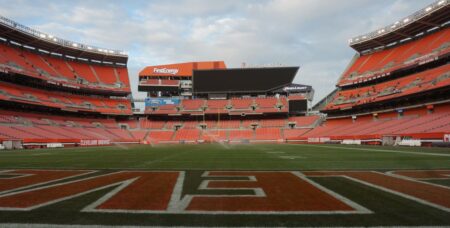The Italian Football Federation (FIGC) has reiterated the need for investment in the country’s stadia infrastructure after reporting landmark revenue figures for the domestic game on the back of increasing matchday income.
The FIGC has published the latest edition of ReportCalcio, an annual look at the state of Italian football it produces in collaboration with professional services company PwC and research agency AREL.
The figures, assessing the 2022-23 season, detail that the Italian football system pulled in revenues of €4.251bn (£3.64bn/$4.64bn), up significantly on the previous year’s figure of €3.43bn. Costs also increased year-on-year, from €4.674bn to €4.929bn, but revenue gains meant net losses were cut from €1.364bn to €864m.
The revenue figure is a record during the period the FIGC has been producing ReportCalcio, now in its 14th edition. The FIGC said this increase is primarily due to the significant growth in gate receipts, which increased from €254m in 2021-22 to €471m in 2022-23, as stadiums fully reopened post-COVID-19, surpassing pre-pandemic figures.
In 2022-23, Serie A on its own reported revenues of slightly over €3.6bn, increasing by 23.6% compared to the 2021-22 season, which was still influenced by COVID-19. The revenues generated from gate receipts amounted to €410.7m, improving by €193m compared to 2021-22. The FIGC said the data related to ticketing is the highest in the entire history of ReportCalcio, highlighting a growth of over €100m compared to the 2018-19 season before the impact of COVID-19.
Serie A’s total attendance during 2022-23 reached a record for figures analysed since 1978-79 with nearly 11.2 million spectators, a 64% increase compared to 2021-22 and a 22% increase on 2018-19. Between 2018-19 and 2022-23, the average attendance per match rose from 24,106 to 29,371 spectators.
The FIGC said an “important variable for sustaining this growth trajectory” lies in the quality of Italy’s stadia, especially considering the co-hosting of UEFA Euro 2032. In October, UEFA confirmed that Euro 2032 will be hosted jointly by Italy and Turkey after the two nations abandoned their individual bids earlier in the year.
The FIGC said the lack of high-level facilities continues to be a “major limitation” for the further development of Italian football. It added that the overall scenario of Italian stadiums remains “highly critical”, with an average age of 66 years, while only 17% of Serie A stadiums use facilities that exploit renewable energy sources and just 10% of Italian professional football stadiums are not publicly owned.
With just five new facilities, the report states Italy accounts for less than 1% of investments in new stadiums in European football made in the period spanning 2007 to 2023, compared to countries such as Turkey and Poland (over 30 new stadiums between 2007 and 2023), but also Germany (18), England (13) and France (12).
However, there has been a concerted push of late across Italy to improve the country’s football infrastructure. In recent weeks alone, AS Roma has given the first look at the design concept for its proposed new stadium in the Pietralata district of Rome, while the Municipality of Verona set out plans for a complete redevelopment of Stadio Marcantonio Bentegodi in order to secure its place as a venue for Euro 2032.
Other projects involving Serie A clubs at varying levels of development or planning include the likes of Inter Milan, AC Milan, Atalanta, SS Lazio, Bologna, Cagliari, Fiorentina, Parma and Venezia.
ReportCalcio states the 18 projects currently in the planning or actual construction phase foresee an investment of over €3bn, which would produce a further impact on the Italian GDP of €5.6bn, €2.5bn in additional tax revenues and approximately 14,000 new jobs.





